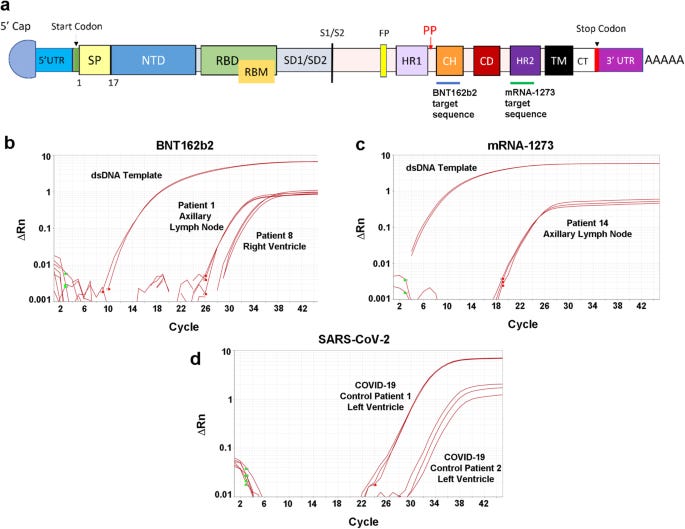In the dire days of the pandemic, mRNA vaccines emerged as a beacon of hope , with the promise of training our cells to combat the menacing virus - or so it was thought. The innovative mRNA framework and delivery mechanism was simple and seemingly straightforward - the mRNA encased in lipid nanoparticles would stay in the arm, translate into the spike protein, and elicit an immune response.
However, a recent ground-breaking study, conducted by Krauson et al., dives into something we now have REPLETE evidence for: revealing that the trajectory of mRNA vaccines extends beyond the anticipated boundaries, unveiling a concerning voyage through the human body.
The researchers developed a PCR test to track the biodistribution of mRNA vaccines, discovering their presence in axillary lymph nodes up to 30 days post-vaccination and more…. A striking revelation that confronts the initial assumptions head-on. The persistence of these vaccines in certain tissues, particularly in the heart, opens the door to a myriad of questions regarding the long-term interactions between these foreign mRNA molecules and our bodily systems, a voyage initially supposed to be short-lived, now apparently lingering.
Delving deeper, the study unearthed a startling connection between the presence of mRNA vaccines in the cardiac tissues and healing myocardial injuries. The vaccines were detected in the heart of some recently vaccinated patients, a revelation that sends ripples through our understanding of mRNA vaccines' interaction with our bodies. The implications of these findings are profound and summon a closer scrutiny into the cardiac involvement post mRNA vaccination.
Here are some of the key statistics and findings extracted from the study:
Vaccine mRNA was detected in 8 of 11 (73%) axillary lymph node samples from patients dying within 30 days of vaccination, but not in any samples from patients dying after 30 days.
Vaccine was detected in the myocardium (heart muscle) in 2 left ventricle samples and 2 right ventricle samples from 3 patients vaccinated within 30 days of death.
All 3 patients with vaccine detected in the heart had healing myocardial injury that predated or coincided with vaccination.
Cardiac ventricles with vaccine detected had more myocardial macrophages compared to ventricles without vaccine (mean 0.62 vs 0.0 macrophages per high power field, p=0.0003).
Vaccine mRNA was not detected in mediastinal lymph nodes, liver, or spleen samples from any patient.
20 vaccinated patient autopsies were examined. 13 received Pfizer, 7 received Moderna.
Vaccine persistence up to 30 days post-vaccination was observed, but not beyond.
In summary, the key findings are the detection of vaccine mRNA in lymph nodes and heart tissue up to 30 days post-vaccination, association with prior myocardial injury, and lack of detection in other organs studied. The sample size was relatively small at 20 patients but confirms the GROWING list of case reports we have
The association of myocardial injury with vaccine detection in the heart unveils a potentially crucial aspect of vaccine interaction within our cardiac tissues. Though the exact mechanism remains elusive, this finding beckons a more in-depth investigation into the myocardial interplay with mRNA vaccines.





To postulate that something injected into the human body would remain in one single location is a proposition so preposterous as to boggle the mind.
They lied? Impossible!